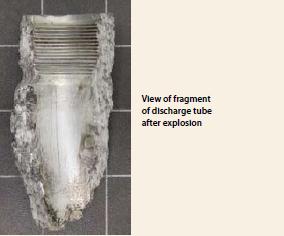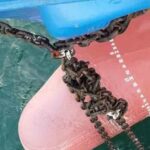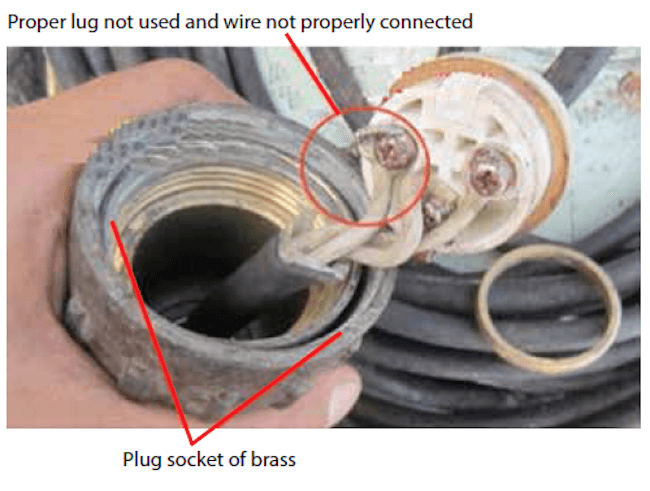Breathing Apparatus Air Compressor Explosion Injures 3rd Officer
Real Life Accident: A 3rd Officer on board a cargo ship suffered burns to his hands and face when he wrongly used a self-contained breathing apparatus (SCBA) air compressor to refill an oxygen breathing apparatus (OBA) cylinder, causing it to explode.
Background of incident
The vessel’s managers had decided to supplement the ship’s mandatory SOLAS fire-fighting equipment with additional OBA sets, but this was not followed up with proper crew familiarisation and maintenance training for this specialized equipment.
The 3/O, who had already served as a rating on a few contracts on vessels of the fleet that were supplied with OBA sets, was fundamentally ignorant of the differences between air and oxygen, and the breathing apparatus using these two mediums. He was also unaware that the oxygen cylinders were meant to be refilled only ashore.
On the day of the incident, he had informed the C/O of his intention to carry out the routine inspection and maintenance of BA sets after his bridge watch. The C/O agreed to assist, but, not wanting to disturb the C/O’s pre-arrival preparations, the 3/O unilaterally decided to use the assistance of an able seaman (A/B) for the task.
Having noticed that the residual pressure in one of the OBA cylinders had fallen to well below the optimum, the 3/O removed the set to the steering gear compartment, where the SCBA air compressor was located. He tried to screw the SCBA air compressor discharge hose connector on to the OBA cylinder valve, but it did not fit. He then found an adaptor in the box next to the compressor that fitted both the OBA cylinder and the compressor discharge hose connector, tightened all the connections and opened the OBA cylinder valve.
Within a few seconds of starting the compressor, the air discharge tube exploded. A fire started around the compressor, temporarily engulfing the 3/O and inflicting serious burns to his face and hands. As he rushed to the accommodation to get medical help, the A/B raised the fire alarm and managed to extinguish the fire with a portable extinguisher. In the accommodation, the 3/O encountered the C/O and two cooks, who promptly removed the 3/O’s burnt coveralls and proceeded to cool the injured skin with running water. They then removed the casualty to the ship’s hospital where further first aid treatment was provided. Later that evening, in the course of filing a routine position report, the Master indirectly advised the shore of the incident and requested radio medical advice. After due consideration, the shore authorities made arrangements for a rendezvous and helicopter medical evacuation (medevac). The injured person was transferred to a hospital ashore for further treatment, after which he was discharged and repatriated to his home country.
Analysis of Incident
1. The investigation found that the explosion occurred as a result of a fire that started within the compressor when oil ignited in the hot, oxygen-rich environment. When the 3/O opened the OBA cylinder outlet valve, gaseous oxygen (pressurized to about 7 MPa) flowed from the cylinder into the compressor discharge hose and tube which contained air at atmospheric pressure (0.1 MPa). The oxygen continued to flow until the pressure inside the discharge hose and tube reached equilibrium with the pressure inside the OBA cylinder. During this process, it is likely that the temperature of the oxygen-rich environment within the discharge hose and tube dramatically increased as a result of adiabatic compression. Calculations indicate that the temperature of the oxygen may have reached about 700°C as a result of adiabatic compression alone.

2. When oxygen within a system is compressed rapidly, with no heat loss to the surrounding materials, it causes a rapid temperature rise in the gas. Within seconds, the temperature of the oxygen-rich environment would have exceeded the auto ignition temperature of any oil that had been trapped in the discharge tube filter, or any other part of the discharge circuit. Once the oil ignited, a near instantaneous over-pressurisation within the compressor caused the rupture of the discharge tube and hose. A flame front was then blown out of the compressor, engulfing the 3/O.
3. Although the compressor adaptor was fitted with a relief valve, it was not designed to cope with the instantaneous pressurisation that occurred inside the compressor when the oil was ignited in the oxygen-rich environment.
4. There are internationally recognized color schemes used in industry so that high pressure cylinders containing different gases can be easily identified. There are also a number of different types of engineering controls that prevent a high pressure cylinder from being connected to an incompatible system – e.g. an oxygen / acetylene set – the threads on the high-pressure oxygen cylinder are right handed, whereas the threads on the acetylene cylinder are left handed, preventing incorrect connections. The SCBA and OBA sets supplied on board were compliant with European and Japanese standards respectively, and had different threaded connections. But, due to an unfortunate coincidence, the spare compressor discharge hose adaptor that was found in the box near the SCBA compressor allowed the connection of the Japanese-made OBA cylinders to the European-made air compressor.
5. The 3/O had been sailing in that rank for about 3 months, and was considered to be sufficiently trained in the use and maintenance of SCBA sets, having participated in many fire drills and the refilling of such cylinders.
6. The crew on board understood that the OBA sets had been supplied to all ships as an additional resource for fighting fires. However, they were not all familiar with the operation and maintenance requirements associated with them. The Master and C/O understood that the OBA set cylinders contained oxygen and that they had to be sent ashore for re-filling, but the 3/O was not aware of this requirement.
7. Since OBA sets are not part of a ship’s mandatory SOLAS fire fighting equipment, they were not included in approved seafarer training courses. Therefore, the responsibility for appropriately training the crew lay solely with the vessel’s operators and its senior officers. It also was apparent that all onboard fire drills on the vessel invariably involved only the use of SCBA sets.
8. Copies of the OBA set operating manual were available onboard, but had inadvertently been omitted from the SOLAS training manual, presumably due to the fact they were supplied afterwards.
9. The onboard Safety Management System (SMS) included a fire fighting manual, which contained some basic information regarding the differences between BA sets and OBA sets, but no information regarding their operation and maintenance.

Root cause/contributory factors
1. The ship’s safety management system did not provide the crew with appropriate guidance in relation to the operation and maintenance of the OBA sets.
2. The air compressor was not fitted with a filter designed to prevent contaminants or oil from carrying over with the discharge air.
Corrective / preventative actions
1 The ship’s safety management system documentation to include appropriate guidance in relation to the operation and maintenance of OBA sets;
2 The company has forwarded a safety bulletin to all ships advising staff to:
- re- fill all OBA oxygen cylinders ashore;
- clearly mark the word ‘oxygen’ in English on all OBA oxygen
cylinders; - post signs on all breathing apparatus compressors stating that
they are only to be used to re-fill air breathing apparatus and
emergency escape breathing device (EEBD) cylinders; - seek approval from a responsible person prior to re-filling
cylinders; and - assign more than one crew member to the task of re-filling
cylinders.
3 All OBA cylinders to be supplied in the future will be permanently labelled to indicate that the re-filling of the cylinders with oxygen must only be carried out ashore.
Do you have info to share with us ? Suggest a correction
- Real Life Incident: Vessel Collision in Good Visibility
- Real Life Incident: Severe Injury To Deck Crew While Leaving Berth
- Real Life Incident: Departure Damage in Very Restricted Waterway
- Real Life Incident: Low Situational Awareness Has High Impact Consequence
- Real Life Incident: Fouled Anchor in a Designated Anchorage
- Real Life Incident: Fire On Barge Carrying Scrap Metal Causes $7 Million Worth Of Damage
Latest Case studies Articles You Would Like:
Subscribe To Our Newsletters
By subscribing, you agree to our Privacy Policy and may receive occasional deal communications; you can unsubscribe anytime.
















Officers who is assigned responsible of refilling oxygen bottles for breathing apparatus must take extra care and if in doubt of operation for charging this O.B.A he/she must read first the makers instruction manual on how to refill or a photo copy of this instruction manual must be posted inside the breathing compressor room clearly stated the procedure on how to operate the equipment and the safety standard must be follow to avoid the rest of explosion..a defective compressor such blow by from liner wear or defective piston rings due to wear limits of poor maintenance may result of carry over of oil mixture from the crank case to the charging air bottles also if the discharge filter is also over used oil mixture will mixed to the compressed air as this pressure inside the cylinder bottle with developed it increasing pressure the air temp will increase in temperature with the mixture of oil any leaks coming from air charging breathing com pressure can be a danger of auto ignition resulting to burn off the high pressure rubber hose which tends to result into adiabatic explosion due a high pressure released from the charging oxygen cylinder and can captured due to explosion pressure resulting to fire on that space..to avoid increase temp of charging this O.B.A cylinder bottle must be submerge into the water in a bucket of container only the upper portion of the charging valve is exposed from the water to cool down the bottles and the air inside just to reduced or control the high temp of the compressed air..this can be a safer way of charging the SCBA sets..
What-a-pity, sorry 4 d urgly incident. 3rd officer, should h’v been under a close watchful eye of a snr, officer in heirachy.. And possibly must hv ignored basic equipment’s operational manual/instructions, & possible (w.o/wp) work permit 4rm cptn. On board.
all accident occurred by human error